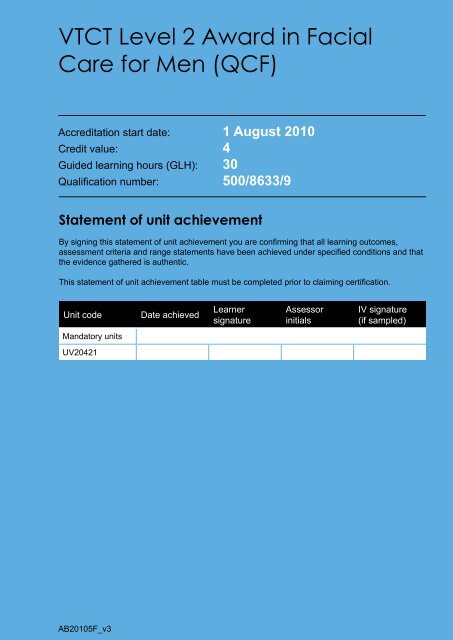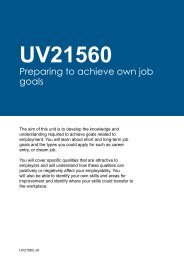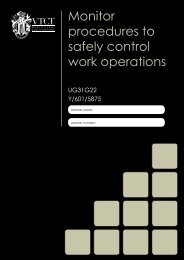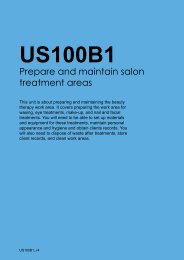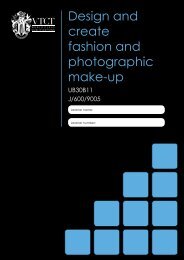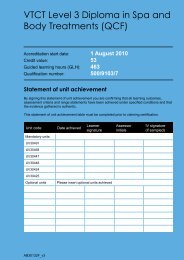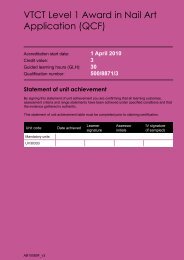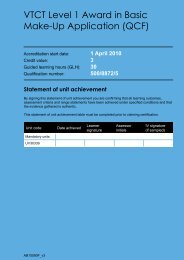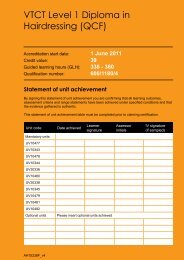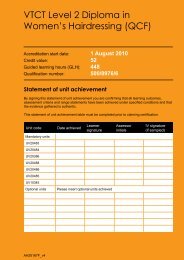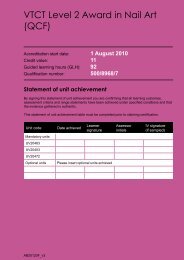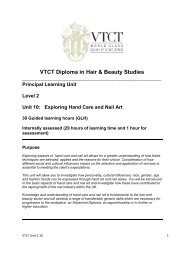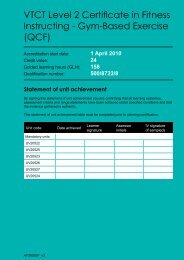VTCT Level 2 Award in Facial Care for Men (QCF)
VTCT Level 2 Award in Facial Care for Men (QCF)
VTCT Level 2 Award in Facial Care for Men (QCF)
- TAGS
- vtct
- level
- award
- facial
- vtct.org.uk
Create successful ePaper yourself
Turn your PDF publications into a flip-book with our unique Google optimized e-Paper software.
<strong>VTCT</strong> <strong>Level</strong> 2 <strong>Award</strong> <strong>in</strong> <strong>Facial</strong><br />
<strong>Care</strong> <strong>for</strong> <strong>Men</strong> (<strong>QCF</strong>)<br />
Accreditation start date: 1 August 2010<br />
Credit value:<br />
4<br />
Guided learn<strong>in</strong>g hours (GLH): 30<br />
Qualification number: 500/8633/9<br />
Statement of unit achievement<br />
By sign<strong>in</strong>g this statement of unit achievement you are confirm<strong>in</strong>g that all learn<strong>in</strong>g outcomes,<br />
assessment criteria and range statements have been achieved under specified conditions and that<br />
the evidence gathered is authentic.<br />
This statement of unit achievement table must be completed prior to claim<strong>in</strong>g certification.<br />
Unit code Date achieved<br />
Mandatory units<br />
UV20421<br />
AB20105F_v3<br />
Learner<br />
signature<br />
Assessor<br />
<strong>in</strong>itials<br />
IV signature<br />
(if sampled)
2<br />
The qualification<br />
Introduction National Occupational Standards (NOS)<br />
The <strong>VTCT</strong> <strong>Level</strong> 2 <strong>Award</strong> <strong>in</strong> <strong>Facial</strong> <strong>Care</strong> <strong>for</strong> <strong>Men</strong><br />
(<strong>QCF</strong>) is a qualification that has been<br />
specifically designed to develop your practical<br />
skills <strong>in</strong> groom<strong>in</strong>g and sk<strong>in</strong> care to <strong>in</strong>clude facial<br />
cleans<strong>in</strong>g us<strong>in</strong>g cleansers and exfoliat<strong>in</strong>g<br />
products, facial steam<strong>in</strong>g us<strong>in</strong>g hot towels,<br />
application and removal of face masks, shap<strong>in</strong>g<br />
(tweez<strong>in</strong>g) eyebrows and the theory of different<br />
shav<strong>in</strong>g methods.<br />
The purpose of this qualification is to<br />
develop your practical skills to a high level of<br />
occupational ability to enable you to per<strong>for</strong>m<br />
facial care treatments <strong>for</strong> men.<br />
Units <strong>in</strong> this qualification have been mapped<br />
to the relevant NOS (where applicable). This<br />
qualification is accredited on the Qualifications<br />
and Credit Framework (<strong>QCF</strong>).<br />
This qualification is approved and supported by<br />
the Hairdress<strong>in</strong>g and Beauty Industry Authority<br />
(HABIA), the standard sett<strong>in</strong>g body <strong>for</strong> hair,<br />
beauty, nails and spa qualifications.
Progression<br />
When you have successfully completed this<br />
qualification you will have the opportunity to<br />
progress to the follow<strong>in</strong>g <strong>VTCT</strong> qualifications:<br />
• <strong>Level</strong> 2 NVQ Diploma <strong>in</strong> Barber<strong>in</strong>g (<strong>QCF</strong>)<br />
• <strong>Level</strong> 2 NVQ Diploma <strong>in</strong> Beauty Therapy<br />
General (<strong>QCF</strong>)<br />
Progression opportunities also exist <strong>in</strong> the<br />
<strong>for</strong>m of specialist <strong>VTCT</strong> vocationally related<br />
qualifications:<br />
• <strong>Level</strong> 2 Diploma <strong>in</strong> Barber<strong>in</strong>g (<strong>QCF</strong>)<br />
• <strong>Level</strong> 2 Certificate <strong>in</strong> Barber<strong>in</strong>g (<strong>QCF</strong>)<br />
• <strong>Level</strong> 2 <strong>Award</strong> <strong>in</strong> Scalp Massage Services<br />
(<strong>QCF</strong>)<br />
• <strong>Level</strong> 2 <strong>Award</strong> <strong>in</strong> Health and Safety <strong>for</strong><br />
Hair and Beauty (<strong>QCF</strong>)<br />
• <strong>Level</strong> 2 <strong>Award</strong> <strong>in</strong> Emergency First Aid at<br />
Work (<strong>QCF</strong>) (HSE Approved)<br />
• <strong>Level</strong> 2 <strong>Award</strong> <strong>in</strong> Prevent<strong>in</strong>g Contact<br />
Dermatitis (<strong>QCF</strong>)<br />
• <strong>Level</strong> 2 Diploma <strong>in</strong> Beauty Specialist<br />
Techniques (<strong>QCF</strong>)<br />
• <strong>Level</strong> 2 Certificate <strong>in</strong> Nail Treatments<br />
(<strong>QCF</strong>)<br />
• <strong>Level</strong> 2 Certificate <strong>in</strong> Beauty Specialist<br />
Techniques (<strong>QCF</strong>)<br />
• <strong>Level</strong> 2 Certificate <strong>in</strong> Depilation (<strong>QCF</strong>)<br />
• <strong>Level</strong> 2 Certificate <strong>in</strong> Nail Technology<br />
(<strong>QCF</strong>)<br />
• <strong>Level</strong> 2 <strong>Award</strong> <strong>in</strong> Nail Art (<strong>QCF</strong>)<br />
• <strong>Level</strong> 2 <strong>Award</strong> <strong>in</strong> Airbrush Nail Design<br />
(<strong>QCF</strong>)<br />
• <strong>Level</strong> 2 <strong>Award</strong> <strong>in</strong> <strong>Facial</strong> Massage and Sk<strong>in</strong><br />
<strong>Care</strong> (<strong>QCF</strong>)<br />
• <strong>Level</strong> 2 <strong>Award</strong> <strong>in</strong> Wax Depilation (<strong>QCF</strong>)<br />
• <strong>Level</strong> 2 <strong>Award</strong> <strong>in</strong> Sugar<strong>in</strong>g Depilation<br />
(<strong>QCF</strong>)<br />
• <strong>Level</strong> 2 <strong>Award</strong> <strong>in</strong> Thread<strong>in</strong>g Depilation<br />
(<strong>QCF</strong>)<br />
• <strong>Level</strong> 2 <strong>Award</strong> <strong>in</strong> <strong>Men</strong>dhi Sk<strong>in</strong> decoration<br />
(<strong>QCF</strong>)<br />
• <strong>Level</strong> 2 <strong>Award</strong> <strong>in</strong> Eyelash Perm<strong>in</strong>g (<strong>QCF</strong>)<br />
• <strong>Level</strong> 2 <strong>Award</strong> <strong>in</strong> Ear Pierc<strong>in</strong>g (<strong>QCF</strong>)<br />
• <strong>Level</strong> 2 <strong>Award</strong> <strong>in</strong> Thermal Auricular<br />
Therapy (<strong>QCF</strong>)<br />
3
4<br />
Qualification structure<br />
Total credits required - 4<br />
All mandatory units must be completed.<br />
Mandatory units - 4 credits<br />
<strong>VTCT</strong> unit<br />
code<br />
Ofqual unit<br />
reference<br />
Unit title Credit value GLH<br />
UV20421 A/601/3567 <strong>Facial</strong> care <strong>for</strong> men 4 30
Guidance on assessment<br />
This book conta<strong>in</strong>s the mandatory units that make up this qualification. Optional units will be<br />
provided <strong>in</strong> additional booklets (if applicable). Where <strong>in</strong>dicated, <strong>VTCT</strong> will provide assessment<br />
materials. Assessments may be <strong>in</strong>ternal or external. The method of assessment is <strong>in</strong>dicated <strong>in</strong><br />
each unit.<br />
Internal assessment<br />
(any requirements will be shown <strong>in</strong> the unit)<br />
Assessment is set, marked and <strong>in</strong>ternally<br />
verified by the centre to clearly demonstrate<br />
achievement of the learn<strong>in</strong>g outcomes.<br />
Assessment is sampled by <strong>VTCT</strong> external<br />
verifiers.<br />
External assessment<br />
(any requirements will be shown <strong>in</strong> the unit)<br />
Externally assessed question papers<br />
completed electronically will be set and marked<br />
by <strong>VTCT</strong>.<br />
Externally assessed hard-copy question papers<br />
will be set by <strong>VTCT</strong>, marked by centre staff and<br />
sampled by <strong>VTCT</strong> external verifiers.<br />
Assessment expla<strong>in</strong>ed<br />
<strong>VTCT</strong> courses are assessed and verified by<br />
centre staff. Work will be set to improve your<br />
practical skills, knowledge and understand<strong>in</strong>g.<br />
For practical elements, you will be observed<br />
by your assessor. All your work must be<br />
collected <strong>in</strong> a portfolio of evidence and crossreferenced<br />
to requirements listed <strong>in</strong> this record<br />
of assessment book.<br />
Your centre will have an <strong>in</strong>ternal verifier whose<br />
role is to check that your assessment and<br />
evidence is valid and reliable and meets <strong>VTCT</strong><br />
and regulatory requirements.<br />
An external verifier, appo<strong>in</strong>ted by <strong>VTCT</strong>, will<br />
visit your centre to sample and quality-check<br />
assessments, the <strong>in</strong>ternal verification process<br />
and the evidence gathered. You may be<br />
asked to attend on a different day from usual if<br />
requested by the external verifier.<br />
This record of assessment book is your<br />
property and must be <strong>in</strong> your possession when<br />
you are be<strong>in</strong>g assessed or verified. It must be<br />
kept safe. In some cases your centre will be<br />
required to keep it <strong>in</strong> a secure place. You and<br />
your course assessor will together complete<br />
this book to show achievement of all learn<strong>in</strong>g<br />
outcomes, assessment criteria and ranges.<br />
5
6<br />
Creat<strong>in</strong>g a portfolio of evidence<br />
As part of this qualification you are required to<br />
produce a portfolio of evidence. A portfolio will<br />
confirm the knowledge, understand<strong>in</strong>g and skills<br />
that you have learnt. It may be <strong>in</strong> electronic or<br />
paper <strong>for</strong>mat.<br />
Your assessor will provide guidance on how to<br />
prepare the portfolio of evidence and how to<br />
show practical achievement, and understand<strong>in</strong>g<br />
of the knowledge required to successfully<br />
complete this qualification. It is this booklet<br />
along with the portfolio of evidence that will<br />
serve as the prime source of evidence <strong>for</strong> this<br />
qualification.<br />
Evidence <strong>in</strong> the portfolio may take the follow<strong>in</strong>g<br />
<strong>for</strong>ms:<br />
• Observed work<br />
• Witness statements<br />
• Audio-visual media<br />
• Evidence of prior learn<strong>in</strong>g or atta<strong>in</strong>ment<br />
• Written questions<br />
• Oral questions<br />
• Assignments<br />
• Case studies<br />
All evidence should be documented <strong>in</strong> the<br />
portfolio and cross referenced to unit outcomes.<br />
Construct<strong>in</strong>g the portfolio of evidence should not<br />
be left to the end of the course.<br />
Many frequently asked questions and other<br />
useful <strong>in</strong><strong>for</strong>mation are detailed <strong>in</strong> the <strong>VTCT</strong><br />
Candidate’s Handbook, which is available on<br />
the <strong>VTCT</strong> website at www.vtct.org.uk/students.<br />
Other questions should be addressed to the<br />
tutor, lecturer or assessor.
Unit assessment methods<br />
This section provides an overview of the assessment methods that make up each unit <strong>in</strong> this<br />
qualification. Detailed <strong>in</strong><strong>for</strong>mation on assessment is provided <strong>in</strong> each unit.<br />
Mandatory units<br />
<strong>VTCT</strong> unit<br />
code<br />
Unit title<br />
External Internal<br />
Question<br />
paper(s)<br />
Observation(s) Assignment(s)<br />
UV20421 <strong>Facial</strong> care <strong>for</strong> men 0 � �<br />
7
8<br />
Unit glossary<br />
<strong>VTCT</strong> product<br />
code<br />
Description<br />
All units are allocated a unique <strong>VTCT</strong> product code <strong>for</strong> identification purposes.<br />
This code should be quoted <strong>in</strong> all queries and correspondence to <strong>VTCT</strong>.<br />
Unit title The title clearly <strong>in</strong>dicates the focus of the unit.<br />
National<br />
Occupational<br />
Standards<br />
(NOS)<br />
<strong>Level</strong><br />
Credit value<br />
Guided<br />
learn<strong>in</strong>g hours<br />
(GLH)<br />
Observations<br />
Learn<strong>in</strong>g<br />
outcomes<br />
Evidence<br />
requirements<br />
Maximum<br />
service times<br />
Observation<br />
outcome<br />
Knowledge<br />
outcome<br />
Assessment<br />
criteria<br />
Range<br />
NOS describe the skills, knowledge and understand<strong>in</strong>g needed to undertake a<br />
particular task or job to a nationally recognised level of competence.<br />
<strong>Level</strong> is an <strong>in</strong>dication of the demand of the learn<strong>in</strong>g experience, the depth<br />
and/or complexity of achievement and <strong>in</strong>dependence <strong>in</strong> achiev<strong>in</strong>g the<br />
learn<strong>in</strong>g outcomes. There are 9 levels of achievement with<strong>in</strong> the Qualifications<br />
and Credit Framework (<strong>QCF</strong>).<br />
This is the number of credits awarded upon successful achievement of all unit<br />
outcomes. Credit is a numerical value that represents a means of recognis<strong>in</strong>g,<br />
measur<strong>in</strong>g, valu<strong>in</strong>g and compar<strong>in</strong>g achievement.<br />
GLH is an estimate of the time allocated to teach, <strong>in</strong>struct, assess and<br />
support learners throughout a unit. Learner <strong>in</strong>itiated private study, preparation<br />
and mark<strong>in</strong>g of <strong>for</strong>mative assessment is not taken <strong>in</strong>to account.<br />
This <strong>in</strong>dicates the m<strong>in</strong>imum number of observations required to achieve the<br />
unit.<br />
The learn<strong>in</strong>g outcomes are the most important component of the unit, they set<br />
out what is expected <strong>in</strong> terms of know<strong>in</strong>g, understand<strong>in</strong>g and practical<br />
ability as a result of the learn<strong>in</strong>g process. Learn<strong>in</strong>g outcomes are the results<br />
of learn<strong>in</strong>g.<br />
This section provides guidel<strong>in</strong>es on how evidence must be gathered.<br />
The maximum time <strong>in</strong> which a particular service or practical element must be<br />
completed.<br />
An observation outcome details the practical tasks that must be completed to<br />
achieve the unit.<br />
A knowledge outcome details the theoretical requirements of a unit that must<br />
be evidenced through oral question<strong>in</strong>g, a mandatory written question paper or<br />
portfolio of evidence.<br />
Assessment criteria set out what is required, <strong>in</strong> terms of achievement, to meet<br />
a learn<strong>in</strong>g outcome. The assessment criteria and learn<strong>in</strong>g outcomes are the<br />
components that <strong>in</strong><strong>for</strong>m the learn<strong>in</strong>g and assessment that should take place.<br />
Assessment criteria def<strong>in</strong>e the standard expected to meet learn<strong>in</strong>g outcomes.<br />
The range <strong>in</strong>dicates what must be covered. Ranges must be practically<br />
demonstrated <strong>in</strong> parallel to the unit’s observation outcomes.
UV20421<br />
<strong>Facial</strong> care <strong>for</strong> men<br />
This unit is about provid<strong>in</strong>g facial sk<strong>in</strong>care treatments <strong>for</strong><br />
male clients. You will learn about exfoliation, sk<strong>in</strong> warm<strong>in</strong>g,<br />
facial massage, mask treatments and moisturis<strong>in</strong>g<br />
products. You will need to ma<strong>in</strong>ta<strong>in</strong> effective health, safety<br />
and hygiene procedures throughout your work.<br />
UV20421_v5
<strong>Level</strong><br />
Credit value<br />
GLH<br />
2<br />
4<br />
30<br />
Observation(s)<br />
3<br />
External paper(s)<br />
0
<strong>Facial</strong> care <strong>for</strong> men<br />
Learn<strong>in</strong>g outcomes Evidence requirements<br />
On completion of this unit you will:<br />
1. Be able to prepare <strong>for</strong> facial care services<br />
<strong>for</strong> men<br />
2. Be able to provide facial care services <strong>for</strong><br />
men<br />
1. Environment<br />
Evidence <strong>for</strong> this unit must be gathered <strong>in</strong> a<br />
real or realistic work<strong>in</strong>g environment.<br />
2. Simulation<br />
Simulation is not allowed <strong>in</strong> this unit.<br />
3. Observation outcomes<br />
Competent per<strong>for</strong>mance of ‘Observation’<br />
outcomes must be demonstrated to your<br />
assessor on at least three occasions.<br />
4. Range<br />
All ranges must be practically demonstrated<br />
or other <strong>for</strong>ms of evidence produced to<br />
show they have been covered.<br />
5. Knowledge outcomes<br />
There must be evidence that you possess<br />
all the knowledge and understand<strong>in</strong>g<br />
listed <strong>in</strong> the ‘Knowledge’ section of this<br />
unit. This evidence may <strong>in</strong>clude projects,<br />
assignments, case studies, reflective<br />
accounts, oral/written question<strong>in</strong>g and/or<br />
other <strong>for</strong>ms of evidence.<br />
6. Tutor/Assessor guidance<br />
You will be guided by your tutor/assessor<br />
on how to achieve learn<strong>in</strong>g outcomes and<br />
ranges <strong>in</strong> this unit. All outcomes and ranges<br />
must be achieved.<br />
7. External paper<br />
There is no external paper requirement <strong>for</strong><br />
this unit.<br />
UV20421<br />
11
12<br />
Achiev<strong>in</strong>g observations<br />
and range<br />
Achiev<strong>in</strong>g observation outcomes<br />
Your assessor will observe your per<strong>for</strong>mance<br />
of practical tasks. The m<strong>in</strong>imum number<br />
of observations required is <strong>in</strong>dicated <strong>in</strong> the<br />
evidence requirements section of this unit.<br />
Criteria may not always naturally occur dur<strong>in</strong>g<br />
a practical observation. In such <strong>in</strong>stances you<br />
will be asked questions to demonstrate your<br />
competence <strong>in</strong> this area. Your assessor will<br />
document the criteria that have been achieved<br />
through oral question<strong>in</strong>g.<br />
Your assessor will sign off an outcome when all<br />
criteria have been competently achieved <strong>in</strong> a<br />
s<strong>in</strong>gle client service.<br />
Achiev<strong>in</strong>g range<br />
The range section <strong>in</strong>dicates what must<br />
be covered. Ranges should be practically<br />
demonstrated as part of an observation. Where<br />
this is not possible other <strong>for</strong>ms of evidence may<br />
be produced. All ranges must be covered.<br />
Your assessor will document the portfolio<br />
reference once a range has been competently<br />
achieved.<br />
UV20421<br />
Maximum service times<br />
There are no maximum service times that apply<br />
to this unit.
Outcome 1<br />
You can:<br />
a. Prepare yourself, the client and work area<br />
<strong>for</strong> a facial treatment <strong>for</strong> men<br />
b. Use suitable consultation techniques to<br />
identify treatment objectives<br />
c. Identify <strong>in</strong>fluenc<strong>in</strong>g factors<br />
d. Provide clear recommendations to the client<br />
based on factors<br />
*May be assessed through oral question<strong>in</strong>g.<br />
Observations<br />
Be able to prepare <strong>for</strong> facial care services <strong>for</strong> men<br />
Observation 1 2 3<br />
Date achieved<br />
Criteria questioned orally<br />
Portfolio reference<br />
Assessor <strong>in</strong>itials<br />
Learner signature<br />
UV20421 13
14<br />
Outcome 2<br />
Be able to provide facial care services <strong>for</strong> men<br />
You can:<br />
a. Communicate and behave <strong>in</strong> a professional<br />
manner<br />
b. Position yourself and the client correctly<br />
throughout the treatment<br />
c. Select and use products and equipment<br />
tak<strong>in</strong>g <strong>in</strong>to account identified factors<br />
d. Use tweez<strong>in</strong>g techniques, tak<strong>in</strong>g <strong>in</strong>to<br />
account identified factors<br />
e. Follow safe and hygienic work<strong>in</strong>g practices<br />
f. Identify contra-actions and take appropriate<br />
action dur<strong>in</strong>g treatment<br />
g. Provide suitable aftercare advice<br />
h. Complete the treatment to the satisfaction<br />
of the client<br />
i. Evaluate the results of the treatment with<br />
the client<br />
*May be assessed through oral question<strong>in</strong>g.<br />
Observation<br />
Date achieved<br />
Criteria questioned orally<br />
Portfolio reference<br />
Assessor <strong>in</strong>itials<br />
Learner signature<br />
1 2 3<br />
UV20421
*You must practically demonstrate that you have:<br />
Range<br />
Used all consultation techniques Portfolio reference<br />
Question<strong>in</strong>g<br />
Visual<br />
Manual<br />
Reference to client records<br />
Dealt with a m<strong>in</strong>imum of 1 necessary action Portfolio reference<br />
Encourag<strong>in</strong>g client to seek medical advice<br />
Expla<strong>in</strong><strong>in</strong>g why the treatment cannot be carried out<br />
Modify<strong>in</strong>g treatment<br />
Treated all sk<strong>in</strong> types Portfolio reference<br />
Oily<br />
Dry<br />
Comb<strong>in</strong>ation<br />
Carried out all eyebrow services Portfolio reference<br />
Ma<strong>in</strong>tenance of orig<strong>in</strong>al brow shape<br />
Used all massage techniques Portfolio reference<br />
Effleurage<br />
Petrissage<br />
Tapotement<br />
Used all mask treatments Portfolio reference<br />
Sett<strong>in</strong>g<br />
Non-sett<strong>in</strong>g<br />
*It is strongly recommended that all range items are practically demonstrated. Where this is not<br />
possible, other <strong>for</strong>ms of evidence may be produced to demonstrate competence.<br />
UV20421 15
16<br />
*You must practically demonstrate that you have:<br />
Provided all types of advice Portfolio reference<br />
Suitable aftercare products and their use<br />
Avoidance of activities which may cause contra-actions<br />
Recommended time <strong>in</strong>tervals <strong>in</strong>between facial treatments<br />
Home care rout<strong>in</strong>es<br />
*It is strongly recommended that all range items are practically demonstrated. Where this is not<br />
possible, other <strong>for</strong>ms of evidence may be produced to demonstrate competence.<br />
UV20421
Achiev<strong>in</strong>g knowledge outcomes<br />
You will be guided by your tutor and assessor<br />
on the evidence that needs to be produced.<br />
Your knowledge and understand<strong>in</strong>g will be<br />
assessed us<strong>in</strong>g the assessment methods listed<br />
below:<br />
• Observed work<br />
• Witness statements<br />
• Audio-visual media<br />
• Evidence of prior learn<strong>in</strong>g or atta<strong>in</strong>ment<br />
• Written questions<br />
• Oral questions<br />
• Assignments<br />
• Case studies<br />
Develop<strong>in</strong>g knowledge<br />
Where possible your assessor will <strong>in</strong>tegrate<br />
knowledge outcomes <strong>in</strong>to practical observations<br />
through oral question<strong>in</strong>g.<br />
UV20421 17
18<br />
Knowledge<br />
Outcome 1<br />
Be able to prepare <strong>for</strong> facial care services <strong>for</strong> men<br />
You can:<br />
e. Describe salon’s requirement <strong>for</strong> prepar<strong>in</strong>g yourself, the client and<br />
the work area<br />
f. Identify different consultation techniques used to identify treatment<br />
objectives<br />
g. Describe the factors that need to be considered when select<strong>in</strong>g<br />
techniques, products and equipment<br />
h. Describe the environmental conditions suitable <strong>for</strong> facial<br />
treatments <strong>for</strong> men<br />
i. Describe the safety considerations that must be taken <strong>in</strong>to account<br />
when provid<strong>in</strong>g facial treatments <strong>for</strong> men<br />
j. Identify the range of tools and equipment used <strong>for</strong> facial treatments<br />
<strong>for</strong> men<br />
k. Identify products used and their key <strong>in</strong>gredients<br />
l. Outl<strong>in</strong>e the treatments available <strong>for</strong> men’s facial sk<strong>in</strong> care<br />
m. Describe contra-<strong>in</strong>dications that prevent or restrict facial treatments<br />
<strong>for</strong> men<br />
*Assessor <strong>in</strong>itials to be <strong>in</strong>serted if orally questioned.<br />
Requirements highlighted <strong>in</strong> white are assessed <strong>in</strong> the external paper.<br />
UV20421<br />
Portfolio reference /<br />
Assessor <strong>in</strong>itials*
Outcome 2<br />
Be able to provide facial care services <strong>for</strong> men<br />
You can:<br />
j. Describe how to communicate and behave <strong>in</strong> a professional<br />
manner<br />
k. State the importance of position<strong>in</strong>g yourself and the client correctly<br />
throughout the treatment<br />
l. Describe safe and hygienic work<strong>in</strong>g practices<br />
m. Describe the contra-actions which might occur dur<strong>in</strong>g and follow<strong>in</strong>g<br />
the treatment and how to respond<br />
n. Describe the aftercare advice that should be provided<br />
o. State the importance of complet<strong>in</strong>g the treatment to the satisfaction<br />
of the client<br />
p. State the methods of evaluat<strong>in</strong>g the effectiveness of the treatment<br />
q. Describe the use of shav<strong>in</strong>g products<br />
r. Describe methods of shav<strong>in</strong>g<br />
s. State the importance of protect<strong>in</strong>g the eye area correctly<br />
t. Describe methods of m<strong>in</strong>imis<strong>in</strong>g discom<strong>for</strong>t dur<strong>in</strong>g treatments<br />
*Assessor <strong>in</strong>itials to be <strong>in</strong>serted if orally questioned.<br />
Requirements highlighted <strong>in</strong> white are assessed <strong>in</strong> the external paper.<br />
Portfolio reference /<br />
Assessor <strong>in</strong>itials*<br />
UV20421 19
20<br />
Outcome 2 (cont<strong>in</strong>ued)<br />
Be able to provide facial care services <strong>for</strong> men<br />
You can:<br />
u. Describe the normal response of the sk<strong>in</strong> to eyebrow shap<strong>in</strong>g<br />
treatments<br />
v. State the basic sk<strong>in</strong> types and conditions and how to recognise<br />
them<br />
w. Describe the structure and ma<strong>in</strong> functions of the sk<strong>in</strong> and hair<br />
x. State the importance of record<strong>in</strong>g procedures and products used<br />
dur<strong>in</strong>g facial treatments <strong>for</strong> men<br />
*Assessor <strong>in</strong>itials to be <strong>in</strong>serted if orally questioned.<br />
Requirements highlighted <strong>in</strong> white are assessed <strong>in</strong> the external paper.<br />
UV20421<br />
Portfolio reference /<br />
Assessor <strong>in</strong>itials*
Unit content<br />
This section provides guidance on the recommended knowledge and skills required to enable you<br />
to achieve each of the learn<strong>in</strong>g outcomes <strong>in</strong> this unit. Your tutor/assessor will ensure you have the<br />
opportunity to cover all of the unit content.<br />
Outcome 1: Be able to prepare <strong>for</strong> facial care services <strong>for</strong> men<br />
Management of health and safety at<br />
work: Clean up spillages, report slippery<br />
surfaces, remove/report obstacles,<br />
ensure good all round access to trolleys<br />
and equipment, sterilise/dis<strong>in</strong>fect tools,<br />
equipment and work surfaces, wear<br />
personal protective equipment.<br />
Electricity at work – check<strong>in</strong>g/visual<br />
check of equipment, no trail<strong>in</strong>g wires<br />
portable appliance test<strong>in</strong>g (PAT).<br />
Manual handl<strong>in</strong>g – mov<strong>in</strong>g stock, lift<strong>in</strong>g,<br />
work<strong>in</strong>g at heights, unpack<strong>in</strong>g, posture,<br />
deportment, balance, weight, preserve<br />
back, prevent slouch<strong>in</strong>g.<br />
Towels – clean <strong>for</strong> every client, place dirty<br />
towels <strong>in</strong> covered b<strong>in</strong>.<br />
Liability <strong>in</strong>surance – employers’, public,<br />
professional <strong>in</strong>demnity.<br />
Report<strong>in</strong>g of <strong>in</strong>juries, diseases and<br />
dangerous occurrences – accident book,<br />
report<strong>in</strong>g diseases, local by-laws, code of<br />
conduct, risk assessment.<br />
Control of substances hazardous to<br />
health – replace lids, ensure ventilation<br />
<strong>for</strong> vapour and dust, avoid overexposure<br />
to chemicals, use chemicals correctly,<br />
follow storage handl<strong>in</strong>g use and disposal,<br />
correctly dispose of contam<strong>in</strong>ated waste/<br />
products (<strong>in</strong> a closed top b<strong>in</strong>), check end<br />
date on packag<strong>in</strong>g, store away from heat,<br />
damp and direct sunlight, follow relevant<br />
manufacturer’s <strong>in</strong>structions, no smok<strong>in</strong>g,<br />
eat<strong>in</strong>g or dr<strong>in</strong>k<strong>in</strong>g.<br />
Health and safety legislation: Data<br />
protection, electricity at work, employers’<br />
liability (compulsory <strong>in</strong>surance), fire<br />
precautions, first aid at work, health<br />
and safety at work, local government<br />
miscellaneous provisions, occupiers’<br />
liability, local by-laws.<br />
Regulations: Control of substances<br />
hazardous to health, management<br />
of health and safety at work, manual<br />
handl<strong>in</strong>g, personal protective equipment,<br />
report<strong>in</strong>g of <strong>in</strong>juries, diseases and<br />
dangerous occurrences, workplace (health<br />
and welfare).<br />
Employer responsibility: Current and<br />
valid liability <strong>in</strong>surance, display health and<br />
safety rules (cover<strong>in</strong>g staff, employees,<br />
clients and fire evacuation), provide<br />
regular tra<strong>in</strong><strong>in</strong>g, accurate record keep<strong>in</strong>g,<br />
monitor<strong>in</strong>g.<br />
Hazards: Someth<strong>in</strong>g with potential to<br />
cause harm, requir<strong>in</strong>g immediate attention,<br />
level of responsibility, report, nom<strong>in</strong>ated<br />
personnel, duty to recognise/deal with<br />
hazards.<br />
Risk: Likelihood of a hazard happen<strong>in</strong>g,<br />
risk assessment, determ<strong>in</strong>e the level of<br />
risk, preventative measures, reduce a<br />
potentially harmful situation, judgement of<br />
salon hazards, who/what is at risk, level of<br />
risk, <strong>in</strong>terpret results, conclusions, record<br />
f<strong>in</strong>d<strong>in</strong>gs, regular reviews.<br />
Reasons <strong>for</strong> risk assessment: Staff,<br />
visitors, client health and safety, safe<br />
environment, m<strong>in</strong>imise hazards and risks,<br />
requirement of legislation.<br />
UV20421 21
22<br />
Outcome 1: Be able to prepare <strong>for</strong> facial care services <strong>for</strong> men (cont<strong>in</strong>ued)<br />
Hygiene:<br />
General – sterilise and sanitise tools,<br />
dis<strong>in</strong>fect work surfaces, cover cuts and<br />
abrasions, sanitise therapist’s hands be<strong>for</strong>e<br />
and after treatments, sanitise with sprays<br />
and gels, clean towels between clients,<br />
place dirty towels <strong>in</strong> covered b<strong>in</strong>, use<br />
disposable towels, dispense products with<br />
a spatula, pump or spray, use disposables<br />
wherever possible, no smok<strong>in</strong>g, personal<br />
hygiene, replace loose lids, uncapped<br />
bottles and pots.<br />
Sterilisation – (tweezers) autoclave, glass<br />
bead, chemical, UV cab<strong>in</strong>et <strong>for</strong> storage<br />
only.<br />
Dis<strong>in</strong>fection – heat or chemical methods,<br />
bactericides, fungicides, viricides, UV<br />
cab<strong>in</strong>et <strong>for</strong> storage only.<br />
Disposal of waste – s<strong>in</strong>gle use items,<br />
pedal b<strong>in</strong> with a l<strong>in</strong>er, spillages and unused<br />
chemicals, contam<strong>in</strong>ated waste, hazardous<br />
waste, environmental protection.<br />
Therapist posture and deportment:<br />
Correct posture when sitt<strong>in</strong>g, lift<strong>in</strong>g and<br />
carry<strong>in</strong>g, work<strong>in</strong>g methods to avoid<br />
repetitive stra<strong>in</strong> <strong>in</strong>jury (RSI), hand<br />
exercises, stand<strong>in</strong>g posture, even weight<br />
distribution, client com<strong>for</strong>t, ma<strong>in</strong>ta<strong>in</strong><br />
modesty, client correctly positioned to get<br />
maximum benefit from treatment, ensure<br />
technician/therapist position<strong>in</strong>g delivers<br />
appropriate techniques, appropriate space<br />
between client and therapist, prevent <strong>in</strong>jury,<br />
optimum results, allow <strong>for</strong> visual checks.<br />
Work area: Clean and hygienic, height<br />
adjustable chair, correct posture, correct<br />
couch height, light<strong>in</strong>g, ventilation, noise,<br />
music, temperature, ambience, no trail<strong>in</strong>g<br />
wires, no obstructions, tools and equipment<br />
<strong>in</strong> a safe work<strong>in</strong>g position <strong>for</strong> therapist.<br />
UV20421<br />
Client preparation: Protect client cloth<strong>in</strong>g,<br />
ensure client positioned correctly and<br />
com<strong>for</strong>tably, respect privacy and modesty.<br />
Communication:<br />
Verbal – speak<strong>in</strong>g manner and tone,<br />
professional, supportive, respectful,<br />
sensitive to client, open question<strong>in</strong>g related<br />
to treatment.<br />
Non-verbal – eye contact, body language,<br />
listen<strong>in</strong>g.<br />
Record keep<strong>in</strong>g: Accurate appo<strong>in</strong>tment<br />
systems, stationery, loyalty, rewards,<br />
acknowledgement of occasions,<br />
consultation record keep<strong>in</strong>g,<br />
contra-<strong>in</strong>dications, signatures, refer to<br />
exist<strong>in</strong>g records, <strong>in</strong><strong>for</strong>mation clear, accurate<br />
and <strong>in</strong> logical order (name, address,<br />
contact numbers, age range, reason <strong>for</strong><br />
treatment, occupation, sport/hobbies,<br />
medical history, allergies/hypersensitivity,<br />
contact lenses, contra-actions,<br />
contra-<strong>in</strong>dications, sk<strong>in</strong> sensitivity<br />
tests, adaptations and modifications,<br />
recommendations, requirements, treatment<br />
plan), update record at the end of the<br />
treatment, update at each visit, ma<strong>in</strong>ta<strong>in</strong>ed<br />
electronically, paper records.<br />
Professional appearance: Clean<br />
professional uni<strong>for</strong>m, closed <strong>in</strong> footwear,<br />
no jewellery, no pierc<strong>in</strong>gs, hair (neatly tied<br />
back, fr<strong>in</strong>ge secured), light day make-up,<br />
personal hygiene and cleanl<strong>in</strong>ess (shower/<br />
bath, cover cuts and abrasions, deodorant<br />
or antiperspirant), oral hygiene (clean<br />
teeth, fresh breath), nails (good condition<br />
and ma<strong>in</strong>ta<strong>in</strong>ed).<br />
Professional ethical conduct: Polite,<br />
cheerful and friendly manner, friendly facial<br />
expressions, positive attitude, eye contact,<br />
open body language, client relations,
Outcome 1: Be able to prepare <strong>for</strong> facial care services <strong>for</strong> men (cont<strong>in</strong>ued)<br />
confidentiality, respect <strong>for</strong> colleagues and<br />
competitors, avoid gossip, pride <strong>in</strong> work,<br />
punctuality, employer and client loyalty.<br />
Consultation techniques: Client<br />
requirements, client satisfaction, client<br />
expectations and aftercare, signatures,<br />
visual, manual, listen, client card reference.<br />
Treatment objectives: Improved sk<strong>in</strong><br />
condition, client needs and suitability,<br />
realistic outcome, client agreement,<br />
duration and frequency of treatments,<br />
further treatments.<br />
Factors to be considered: Exist<strong>in</strong>g<br />
eyebrow shape, hair growth patterns,<br />
density of hair growth, texture of the hair<br />
and the sk<strong>in</strong>, <strong>in</strong>grow<strong>in</strong>g hairs, adverse sk<strong>in</strong><br />
conditions such as acne vulgaris, and any<br />
unusual features such as moles, scarr<strong>in</strong>g<br />
or facial pierc<strong>in</strong>gs, head shapes, face<br />
shapes, hair styles, facial scarr<strong>in</strong>g, health,<br />
lifestyle, nutrition, the age<strong>in</strong>g process.<br />
Treatments available <strong>for</strong> male clients:<br />
Cleans<strong>in</strong>g, facial washes, exfoliat<strong>in</strong>g,<br />
ton<strong>in</strong>g/astr<strong>in</strong>gents, moisturis<strong>in</strong>g, facial<br />
steam<strong>in</strong>g with hot towels, face masks, sk<strong>in</strong><br />
care and product advice, eyebrow shap<strong>in</strong>g.<br />
Examples of products used:<br />
Cleans<strong>in</strong>g milk – dry/sensitive sk<strong>in</strong>s/<br />
normal/comb<strong>in</strong>ation.<br />
Cleans<strong>in</strong>g cream – ultra dry, deep<br />
cleans<strong>in</strong>g.<br />
Cleans<strong>in</strong>g lotion – oily/congested/<br />
comb<strong>in</strong>ation.<br />
<strong>Facial</strong> wash/cleans<strong>in</strong>g gel – oily sk<strong>in</strong><br />
types, except mature.<br />
Toners:<br />
Toner (freshener) – dry/sensitive/mature.<br />
Toner (astr<strong>in</strong>gent) – oily/problem.<br />
Toner (tonic) – normal.<br />
Moisturis<strong>in</strong>g products:<br />
Moisturiser – day cream, night cream,<br />
product designed <strong>for</strong> sk<strong>in</strong> type.<br />
Eye creams – mature sk<strong>in</strong>/apply to crow’s<br />
feet.<br />
Eye gel – cool<strong>in</strong>g/sooth<strong>in</strong>g.<br />
Neck creams – dry/mature.<br />
Exfoliat<strong>in</strong>g products:<br />
Mechanical – facial brush/brush cleanse<br />
mach<strong>in</strong>e.<br />
Scrub/gra<strong>in</strong>s – uses natural products (e.g.<br />
nuts) or cereals (e.g. porridge).<br />
Clay – gentler to sk<strong>in</strong>.<br />
Awareness of acid peels – glycolic<br />
acid, alpha hydroxyl acid, <strong>for</strong> mature and<br />
photo-damaged sk<strong>in</strong>.<br />
Massage mediums – oil, cream, gel.<br />
Sett<strong>in</strong>g masks:<br />
Clay masks – can be mixed suitable to<br />
sk<strong>in</strong> type.<br />
Peel off masks – choose <strong>for</strong> sk<strong>in</strong> type.<br />
Thermal masks – normal/oily/problem<br />
sk<strong>in</strong>s.<br />
Non-sett<strong>in</strong>g masks:<br />
Warm oil masks – dry/mature.<br />
Natural masks – <strong>in</strong>gredients suitable <strong>for</strong><br />
sk<strong>in</strong> type (examples of possible <strong>in</strong>gredients<br />
– avocado, yoghurt, oats, citrus fruits,<br />
eggs, honey, oats).<br />
Cream masks – pre-prepared, suitable <strong>for</strong><br />
sk<strong>in</strong> type.<br />
UV20421 23
24<br />
Outcome 1: Be able to prepare <strong>for</strong> facial care services <strong>for</strong> men (cont<strong>in</strong>ued)<br />
Selection process: Choice based on sk<strong>in</strong><br />
type, condition, target areas of treatment.<br />
Ma<strong>in</strong> tools: Spatula, facial sponges, mask<br />
brush, comedone extractor.<br />
Ma<strong>in</strong> types of equipment: Couch, stool or<br />
chair, trolley, steamer (optional), hot towels<br />
can be used to warm sk<strong>in</strong>, b<strong>in</strong> with l<strong>in</strong>er,<br />
cotton wool, bowl, mirror, magnify<strong>in</strong>g lamp,<br />
tissues.<br />
Examples of contra-<strong>in</strong>dications that may<br />
prevent treatment: Sk<strong>in</strong> disorders such as<br />
bacterial (impetigo), viral (herpes simplex),<br />
fungal (t<strong>in</strong>ea), systemic medical conditions,<br />
conjunctivitis, severe sk<strong>in</strong> conditions and<br />
eye <strong>in</strong>fections, acne, boils and herpes<br />
zoster and warts, parasitic <strong>in</strong>fection<br />
(scabies).<br />
Examples of contra-<strong>in</strong>dications that may<br />
restrict treatment: Recent scar tissue,<br />
eczema, psoriasis, hyper-keratosis, sk<strong>in</strong><br />
allergies, cuts, abrasion, bruis<strong>in</strong>g, styes.<br />
Examples of possible contra-<strong>in</strong>dications<br />
to steam<strong>in</strong>g: Vascular sk<strong>in</strong> disorders,<br />
respiratory problems, claustrophobia,<br />
broken capillaries, diabetes – loss of<br />
sensation.<br />
UV20421
Outcome 2: Be able to provide facial care services <strong>for</strong> men<br />
Sk<strong>in</strong> analysis: Carried out us<strong>in</strong>g magnify<strong>in</strong>g<br />
lamp, protect eyes, check all areas of the<br />
face and neck <strong>for</strong> sk<strong>in</strong> type, sk<strong>in</strong> conditions<br />
and characteristics, record results on<br />
record card, treatment plan, most suitable<br />
treatment, suitable products, prevent<br />
worsen<strong>in</strong>g of conditions, accurate aftercare<br />
advice, future treatment needs.<br />
Sk<strong>in</strong> types: Normal, oily, dry.<br />
Sk<strong>in</strong> conditions: Mature, sensitive,<br />
dehydrated.<br />
Examples of sk<strong>in</strong> imperfections:<br />
Broken capillaries, pustules, papules milia,<br />
comedones, open pores, f<strong>in</strong>e l<strong>in</strong>es and<br />
wr<strong>in</strong>kles.<br />
Sk<strong>in</strong> characteristics:<br />
Sensitive – often pale sk<strong>in</strong>s, dry, colour<br />
easily, redness, react to products.<br />
Dehydrated – normal sebaceous secretions<br />
but still flaky, tight.<br />
Mature – loss of elasticity, loose muscle<br />
tone, wr<strong>in</strong>kles.<br />
Normal – f<strong>in</strong>e texture, no visible pores,<br />
smooth, supple, flexible.<br />
Oily – sh<strong>in</strong>y, slight thicken<strong>in</strong>g, sallow,<br />
coarse texture, enlarged pores, congestion,<br />
comedones.<br />
Comb<strong>in</strong>ation – comb<strong>in</strong>ation of two or more<br />
sk<strong>in</strong> types, usually oily T-zone, normal or dry<br />
on cheeks.<br />
Dry – lacks moisture, dry to touch, flak<strong>in</strong>ess,<br />
f<strong>in</strong>e texture, th<strong>in</strong>, tight, small pores, broken<br />
capillaries, age<strong>in</strong>g.<br />
Treatment techniques:<br />
Cleans<strong>in</strong>g: <strong>Facial</strong> wash, water based foam<br />
type cleanser used with water then removed<br />
with sponges, exfoliat<strong>in</strong>g product, chemical<br />
or abrasive used follow<strong>in</strong>g manufacturer’s<br />
<strong>in</strong>structions, toners, astr<strong>in</strong>gent, facial<br />
steam<strong>in</strong>g with hot towels.<br />
Steam (optional as hot towels may be<br />
used <strong>in</strong>stead) – pre-heat steamer be<strong>for</strong>e<br />
use, protect the clients’ eyes, protect areas<br />
of broken capillaries with damp cotton wool,<br />
client semi-recl<strong>in</strong>ed, m<strong>in</strong>imum distance<br />
30cm, further away <strong>for</strong> more sensitive<br />
sk<strong>in</strong>s, tim<strong>in</strong>g dependant on sk<strong>in</strong> type, follow<br />
manufacturer’s <strong>in</strong>structions.<br />
Extraction – therapist to wear disposable<br />
gloves.<br />
Comedone extractor – should be sterilised<br />
be<strong>for</strong>e use, use loop end and apply gentle<br />
pressure around comedone, wipe away with<br />
damp cotton wool.<br />
F<strong>in</strong>ger extraction – wrap <strong>in</strong> tissue/damp<br />
cotton wool and apply gentle pressure with<br />
<strong>in</strong>dex f<strong>in</strong>gers around comedone, wipe away<br />
with damp cotton wool.<br />
Tools: Tweezers, scissors, disposable<br />
spatulas, sponges, towels.<br />
Tweez<strong>in</strong>g techniques (<strong>in</strong>grow<strong>in</strong>g hairs<br />
or eyebrows): Remove the hair <strong>in</strong> the<br />
direction of hair growth, support surround<strong>in</strong>g<br />
sk<strong>in</strong>, soothe the sk<strong>in</strong> us<strong>in</strong>g cotton pad and<br />
sooth<strong>in</strong>g lotion, tweezers must be sterile.<br />
M<strong>in</strong>imis<strong>in</strong>g discom<strong>for</strong>t: Pressure, stretch,<br />
sooth<strong>in</strong>g lotion, client position, therapist<br />
position.<br />
Massage techniques: Effleurage,<br />
petrissage, tapotement.<br />
Mask application – apply with brush,<br />
choose relevant to sk<strong>in</strong> type, protect<br />
client’s eyes, apply to face and neck,<br />
tim<strong>in</strong>g dependant on sk<strong>in</strong> type (more<br />
sensitive sk<strong>in</strong>s less time, oily sk<strong>in</strong>s longer),<br />
mask type, client com<strong>for</strong>t, manufacturer’s<br />
UV20421 25
26<br />
Outcome 2: Be able to provide facial care services <strong>for</strong> men (cont<strong>in</strong>ued)<br />
<strong>in</strong>structions, remove with damp sponges<br />
and warm water.<br />
Examples of possible contra-actions to<br />
facial sk<strong>in</strong>care treatment/tweez<strong>in</strong>g:<br />
Excessive erythema – apply cold<br />
compress, if the condition persists, client to<br />
seek medical advice.<br />
Allergic reaction – remove product<br />
immediately, apply cold compress, if the<br />
condition persists client to seek medical<br />
advice.<br />
Sk<strong>in</strong> blemishes – do not pick, cont<strong>in</strong>ue<br />
with home care to improve sk<strong>in</strong> condition,<br />
ma<strong>in</strong>ta<strong>in</strong> high levels of hygiene.<br />
Tweez<strong>in</strong>g: Mild blood spots, bruis<strong>in</strong>g.<br />
Normal response: Erythema, mild<br />
puff<strong>in</strong>ess/swell<strong>in</strong>g.<br />
Aftercare advice eyebrow shap<strong>in</strong>g –<br />
apply sooth<strong>in</strong>g and antiseptic products.<br />
Evaluation: Client expectation, client<br />
satisfaction, implications of <strong>in</strong>correct<br />
treatment application.<br />
Methods of shav<strong>in</strong>g (theory only): Wet<br />
and dry (electric) shav<strong>in</strong>g.<br />
Shav<strong>in</strong>g products: Moisturisers, oil or<br />
water based, foams (soap solution released<br />
from a pressurised can <strong>in</strong> a foam<strong>in</strong>g<br />
state), gels (gel solution released from a<br />
pressurised can <strong>in</strong> a foam<strong>in</strong>g state or tube),<br />
soaps, oils (a plant based oil or blend of<br />
vegetable oils), aftershave balm products<br />
to soothe the sk<strong>in</strong> follow<strong>in</strong>g shav<strong>in</strong>g and<br />
astr<strong>in</strong>gent product applied to soothe and<br />
heal after shav<strong>in</strong>g.<br />
Possible contra-actions to shav<strong>in</strong>g:<br />
Shav<strong>in</strong>g rash/cuts/<strong>in</strong>grown hairs, describe<br />
the action to be taken if contra-actions<br />
occur.<br />
UV20421<br />
Aftercare advice shav<strong>in</strong>g (to avoid): Sun,<br />
heat, perfumed products, UV light.<br />
Sk<strong>in</strong>:<br />
Epidermis – basal cell layer (stratum<br />
germ<strong>in</strong>ativum), prickle cell layer (stratum<br />
sp<strong>in</strong>osum), granular layer (stratum<br />
granulosum), clear layer (stratum lucidum),<br />
horny layer (stratum corneum)<br />
Dermis – blood and lymph supply,<br />
fibroblasts (collagen, elast<strong>in</strong>), hair,<br />
sebaceous glands, arrector pili muscle,<br />
dermal papilla, sweat glands (eccr<strong>in</strong>e and<br />
apocr<strong>in</strong>e), sensory nerve end<strong>in</strong>gs.<br />
Hypodermis – subcutaneous layer, adipose<br />
tissue, adipocytes.<br />
Functions of the sk<strong>in</strong> – protection,<br />
heat regulation, absorption, secretion,<br />
elim<strong>in</strong>ation, sensation, <strong>for</strong>mation of<br />
vitam<strong>in</strong> D, melan<strong>in</strong> production, process of<br />
kerat<strong>in</strong>isation.<br />
Structure of the hair – arrector pili muscle,<br />
hair follicle, <strong>in</strong>ner root sheath (Henle’s layer,<br />
Huxley’s layer, cuticle layer), outer root<br />
sheath, vitreous membrane, connective<br />
tissue sheath, root (bulb/matrix, dermal<br />
papilla), sebaceous gland, shaft (medulla,<br />
cortex, cuticle).<br />
Functions of hair – protection aga<strong>in</strong>st cold/<br />
temperature regulation, protection from UV<br />
rays.


